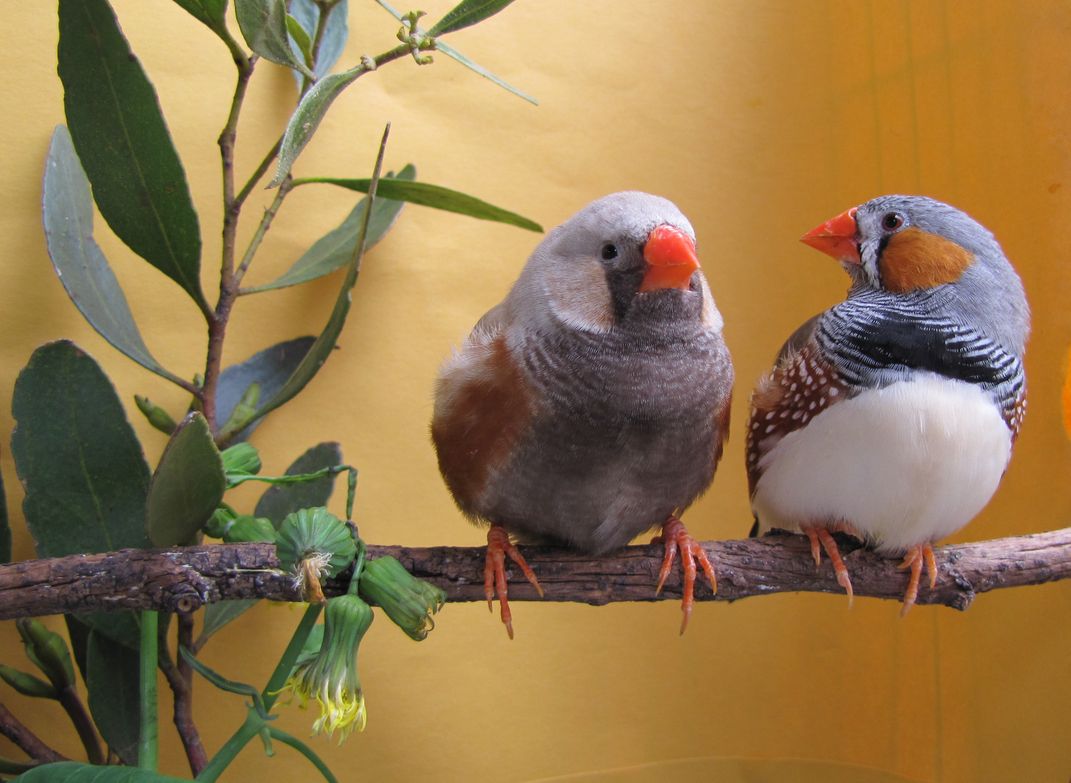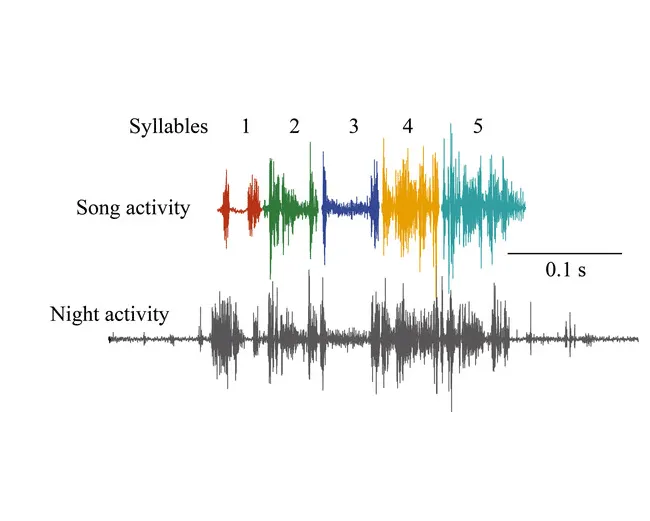Zebra Finches Dream a Little Dream of Melody
Zebra finches flex their singing muscles while snoozing, as if they’re lip-syncing in their sleep—and scientists want to know why
/https://tf-cmsv2-smithsonianmag-media.s3.amazonaws.com/filer/40/36/4036d112-76e8-45f8-bcaf-83a121f49fe6/finches1.jpg)
Zebra finches are so good at singing, they could do it in their sleep. And, according to scientists, they do everything but: As they slumber, zebra finches fire up brain regions and vibrate their vocal cords in ways that mimic wakeful warbling.
In the past two decades, scientists have found that sleep is a critical part of the zebra finch song-learning repertoire. The finches aren’t born belting arias; instead, they learn their songs in adolescence, practicing and tinkering under the supervision of an adult tutor. The tutor will warble patiently for its students, who will then utter their own tentative vocalizations. Hearing their own voices seems to be a crucial element for little zebra finches as they test the notes and syllables out for themselves.
Certainly, practice makes perfect—but even more crucial? A good night’s sleep.
After a hard day at school, each zebra finch heads to bed with music on the mind—so much so that its brain will flicker in and out of the same patterns that occur during daily practice sessions. Its vocal cords vibrate, too, but don’t produce any sound: The birds aren't pushing enough air through their throats to generate audible noise.
Researchers theorize that the birds are, in effect, dreaming of song—more sleep lip-syncing than sleep singing. This may have a lot to do with crystallizing and reshaping material learned from their tutors—a phenomenon comparable to snoozing humans packaging memories and information into long-term storage. In the morning, the finches wake groggy and disoriented, babbling slightly less coherently than the previous day—but as time progresses, their songs improve.
Scientists think that studying how the birds use sleep to learn their songs can help us understand the mysterious process of human language acquisition. Like human speech, the melodies of birdsong are intricate and complex, and even activate brain pathways and muscles very similar to those in humans.

But studying the dreamscape of a slumbering zebra finch is no easy feat: It’s not like we can nudge the birds awake and ask. To better understand the inner workings of these drowsy birdbrains, Gabriel Mindlin’s research group at the University of Buenos Aires decided to move one step further in the chain of musical command. Brains control behavior, but there’s a muscley middleman between the two. To translate the pattern in the brain to a full-blown serenade, a bird’s vocal organ needs to first carry out the marching orders. Together with his colleagues, Mindlin, a professor of biophysics who studies the mechanics of birdsong, designed a system to directly measure the activity of the muscles involved.
In previous work, his research team, in partnership with scientists at the University of Utah, found that zebra finches move their vocal muscles in sync with song-like activity in the brain, indicating that the muscles’ readout could be a good proxy for peeking into the birds’ melodic reveries.
“Now instead of looking at one [brain] cell at a time, we can see the output of the whole system, and that’s very exciting,” says Daniel Margoliash, a professor of neurobiology at the University of Chicago who has studied birdsong for over three decades. Margoliash has previously collaborated with Mindlin’s group but was not involved in these studies.
The study also found that sleep wasn’t just a time to rehearse—it may also give the birds a chance to quietly improvise new tunes. The birds' vocal muscles appear to go slightly on the fritz at night, composing silent songs that don’t stick to the scripts of daytime. This new research was able to capture variation that previous studies of the brain couldn’t, and suggests that the musical mind meanders when zebra finches nod off.
For Mindlin, this was huge. “Now we have a model that doesn’t need the brain,” he says.
Last week, in two new studies, Mindlin’s group expands on their research. Both studies focus on the way scientists study the finches' vocal muscles, in hopes of unlocking more secrets of the slumbering birdbrain.
First, scientists led by Juan Doppler, a physicist working under Mindlin’s supervision, wanted to make it easier to study the birds' muscles. Focusing on the muscles may be a more direct way to capture the mechanics of the serenades of snoozing—but it still isn’t easy. Adult zebra finches must undergo surgery to allow scientists to attach electrodes to multiple muscles.
However, while these muscles are understood to directly control individual aspects of song production—for instance, the pitch of the sound produced—they also need to work together. Several are physically connected, including one particularly important muscle called the syringealis ventralis, which is known to control a song’s frequency.
The team found that measuring the activity of the syringealis ventralis alone could reliably capture the dynamics of birdsong ballads almost as accurately as the old technique of measuring multiple muscles. As expected, the muscle’s activity contained information about frequency, but could also predict when musical motifs started and stopped with over 70 percent accuracy.
“We are moving away from focusing completely on the brain and neurons, and also paying attention to biomechanics, where the information of the nervous system is processed,” says Doppler. “This is a powerful idea. In some cases, looking at the biomechanics can give you insights that are not so clear in the nervous system.”
With Doppler’s simpler system, described in the journal Chaos, the researchers can more easily study the birds’ dream-songs; what’s more, understanding the mechanics of this powerful muscle can also inform how the vocal system works as a functional unit.
“The features of the muscle really bleed through,” says Katherine Tschida, a neurobiologist at Duke University who has studied song learning in zebra finches. “You can get a readout from a single muscle [on] a lot of different features, despite the fact that the muscle isn’t primarily the functional driver of the system.” Tschida, who was not involved in the work, also praised the study for its “high quality” methodology.

In the second study, a team led by Alan Bush, also a physicist in Mindlin’s group, found that they could manipulate the birds into flexing their vocal muscles by playing them versions of their own songs while they slept—a form of harmonic hypnosis. Bush was eager to study the patterns of how muscles actually fired in slumber. To him, the vocal organ is not just a puppet carrying out the brain’s set of master instructions—rather, it’s a creative liaison between brain and behavior that may add its own bells and whistles to the final product. “A lot of the complexity of the system is actually coming from the periphery, where the muscles are,” he explains.
Bush and his colleagues discovered that when the muscles are coaxed into activity, they behave in an all-or-nothing fashion. When played snippets of themselves trilling out tunes, the birds’ muscles would reliably twitch. Even synthetic versions of these songs, remixed in the lab, could sometimes elicit vocal organ responses. Often, the muscles were still—but when they were goaded into flexing, they would carry out the complete firing sequence of a vocalization.
The scientists say this knowledge opens up new ways to study how musical musculature is spurred into action.
Due to the invasiveness of the surgery, Mindlin and his team have only been able to test the muscle responses of adult zebra finches. However, future experiments with more advanced technology may shed light on young birds’ dream states. Such findings might corroborate previous research on how adolescent zebra finches toy with their tutor’s teachings and add their own personal touches during sleep. But what purpose could this serve in adults, who have already mastered their melodies?
Margoliash thinks it’s about maintaining expertise. “If you want to achieve a very high level of precision, you have to work to get there, and practice to stay there,” he explains. “Zebra finches—and humans—need to practice to maintain the quality of performance we achieve.”
Someday, with the combined forces of neuroscience and biophysics, scientists may actually be able to take a deeper dive into the songs of slumber. Technology hasn’t quite caught up to the task—but it’s becoming more powerful with each passing day. Until then? Dream on.
/https://tf-cmsv2-smithsonianmag-media.s3.amazonaws.com/accounts/headshot/10172852_10152012979290896_320129237_n.jpg)
/https://tf-cmsv2-smithsonianmag-media.s3.amazonaws.com/accounts/headshot/10172852_10152012979290896_320129237_n.jpg)